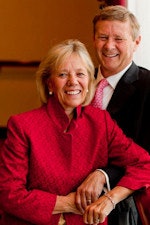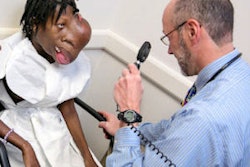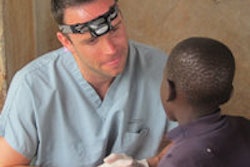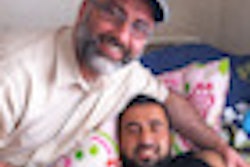
William Magee, DDS, MD, had no intention of starting a charitable organization. In truth, charity wasn't even his primary objective when he asked his wife Kathleen and their 13-year-old daughter to join him on a trip to the Philippines in 1982 to offer pro bono treatment of children with cleft lip and cleft palate.
After that inaugural journey, he and Kathleen founded Operation Smile, a humanitarian organization providing free reconstructive surgery for children and adults with cleft lip, cleft palate, and other facial deformities. Today, the organization has a presence in some 60 countries and has performed more than 200,000 free surgeries and more than 2 million patient evaluations. It has been praised by Mother Teresa, received the President's Volunteer Action Award from George H.W. Bush, and been honored by Pope John Paul II.
To learn more about their efforts and how the dental community can participate in this global charity, which reported total liabilities and net assets of $25.4 million in fiscal 2010, DrBicuspid.com spoke with Dr. Magee and William Davidson, DDS, PhD, chair of Operation Smile's dental council, who has been with the organization since 1992.
DrBicuspid.com: What inspired the creation of Operation Smile?
 William Magee, DDS, MD, and his wife Kathleen founded Operation Smile in 1982. He is the executive chairman and she volunteers full time as the organization's president. All of their five children have served on medical missions.
William Magee, DDS, MD, and his wife Kathleen founded Operation Smile in 1982. He is the executive chairman and she volunteers full time as the organization's president. All of their five children have served on medical missions.Dr. Magee: In 1975 I got a Hays-Fulbright Scholar Grant to study with Paul Tessier, MD, the father of craniofacial surgery, in Paris. Then in 1982, I got an invitation to go to the Philippines to help kids with clefts, and I wanted to get more experience in operating on children with cleft lip and cleft palates.
My wife Kathleen has a pediatric nursing background, with a master's degree in social work and a master's in human development, and she and our 13-year-old daughter went on that trip too, and it was unbelievable! We went to three sites, each for about two days. At the third site, 300 kids and their families came to see us, but we could only take care of about 40 of them. So we watched more than 250 kids get sent away without anything. It was heartbreaking. There was a lady with a ripe basket of bananas she had cradled in her arms. Her daughter of maybe 8 years of age had a big hole in her lip, and the lady said 'I'd like to give you these bananas as a gift for trying to take care of my daughter,' even though we had turned her away. She had tears coming down her cheeks, and we had tears coming down our cheeks, and all we could say was "Maybe next year." But there was no next year. The group we were with was not planning on coming back.
So Kathleen and I said, "Why don't we get a group together of our friends and go back to take care of those kids?" There was no big idea of forming an organization, it was just about taking care of the kids we turned away. So we went back and treated 150, but again saw another 250 get turned away. We went back again but turned away 300 -- and it just never ever ended.
We realized there was nobody to take care of these kids. With a population of 80 million in the Philippines, statistically there are 160,000 with clefts. I had never thought about that before or seen anything like that, since everyone in the U.S. is taken care of.
We also realized what an incredible experience it was, beyond the cleft lip and palate, to understand the needs of the developing world. As our friends brought their friends, it continued to grow virally, and the infrastructure was continually put beneath it.
How big is the organization today?
Today we have about 5,500 volunteers and 300 employees worldwide. We'll send out more than 170 missions this year. We also conduct a youth conference each summer for high school students, where we bring two high school kids on every trip with a youth sponsor.
We're coming up to the 10th anniversary for our London office, which raises a lot of money for us and continues to grow. From our office in Cape Town, South Africa, we've expanded into eight to 10 countries in sub-Saharan Africa. We're doing our first mission into Ghana. We originally were there in the late '80s and early '90s but stopped because of unrest. Those renewed efforts are funded by our office in Rome. Santo Versace is our chairperson of the board there. We also have offices in Dublin; Hong Kong; Brisbane, Australia; and Stockholm.
Dr. Davidson, what drew you to Operation Smile?
— William Davidson, DDS, PhD, Operation
Smile
Dr. Davidson: I became very much interested in craniofacial defects starting back in the 1970s when I was an assistant professor at Johns Hopkins, and eventually I got involved with a cleft palate team there. One day there was a meeting about Operation Smile at the University of Maryland, spearheaded by Dr. Magee's son, who is a pediatric dentist. It sounded really interesting, and I was at a point where I felt I needed to change. I've always had the belief that I'm fortunate and that if I give back, that's a good thing.
And once you've seen the need, seen the patients and the young parents who are scared to death, and you help them, it becomes a joy. I did as much as I could, and eventually I got involved with the organizational side.
What kinds of opportunities does Operation Smile offer dental practitioners?
Dr. Davidson: We have two kinds of missions. The first is the medical mission, primarily a plastic surgery mission for those with cleft palate. The dentist is there to support the surgeon and facilitate the surgery by extracting teeth that would interfere with postoperative healing.
 Dr. Magee with a young patient. Operation Smile encourages volunteerism, but also works to establish self-sufficiency in their host countries.
Dr. Magee with a young patient. Operation Smile encourages volunteerism, but also works to establish self-sufficiency in their host countries.Some patients arrive with palate issues that may not be as severe as others. Our priority list favors those with the most severe defects. Others with holes in their palates probably won't have surgery simply because there are so many. The dentist might place an obturator to restore part of the palate prosthetically. There's also teaching of local dentists that goes on at some sites.
The other mission is a dental mission. This is the mission that was started at the University of Maryland in the 1990s. It first took place in Vietnam. The initial idea was for our students and their students to collaborate, while the faculty oversaw the mission. We put together a symposium and participated in training at a permanent center there, and we sent vans out to provide care in the countryside.
Today, Operation Smile is working to establish centers like the one in Vietnam in other countries and already has facilities in Colombia, Honduras, and China.
Hygienists also are involved in the dental missions. They go out to the schools to teach the teachers and students in order to improve their understanding of how to take care of their mouths. The school systems are great. The kids get excited, and the parents are appreciative. Once you do it, it's hard to get it out of your system.
What additional support do you need from the dental community?
Dr. Davidson: Anyone who's interested. Prosthodontists, orthodontists, and pediatric dentists have had the training, without a doubt. With the other disciplines, it depends on the individual's knowledge. There is an Operation Smile education website where they can explore the role of the dentist. It's a modification of what people already know and do. We want to get them tuned up to be an efficient contributor onsite. Enthusiasm is what it's all about. Flexibility and the ability to improvise also are key.
Many are looking for a working vacation in an exotic place. And no doubt about it, the places are exotic, but it's no vacation -- perhaps afterward. The mission itself takes about a week or so from screening to breakdown.
And people need to realize: We go to help, but we're also ambassadors for the U.S. The egos have to stay home.
Is Operation Smile continuing to grow?
Dr. Magee: We're getting ready for our 30th anniversary, which we're calling "The Journey Home." The original home of Operation Smile was the Philippines, so we're going to about eight sites there and bringing in volunteers from all over the world as a way of thanking the Filipinos for allowing Operation Smile to begin. Had they not, then all these volunteers worldwide would have never been involved with something that's enriched all of their lives.
|
Millions in donated support Operation Smile’s financial statement is as massive as its outreach efforts. The organization's revenues -- the lion's share from financial donations, donated services, and gifts-in-kind -- totaled nearly $67 million for fiscal year 2010. Expenditures on medical missions, education, and sustainability reached $47 million. Operation Smile also spent $15.7 million and $1.5 million, respectively, on fundraising and administration in 2010. |
It just continues to grow all the time. The real tribute to the growth of the organization is the collective work of so many individuals and donors. We have a new program we opened in Guwahati, India, for instance, that offers comprehensive care, with orthodontics, speech therapy, and an eight-table operating room. It's being funded with a public/private partnership. The state of Assam kicked in $5 million, and we went to Ratan Tata, a steel and transportation industrialist, and asked him to match it. He agreed, so we had $10 million to develop a new system of care delivery in a state that only had one or two surgeons previously to take care of all the need that existed.
There are so many things happening like that. If it wasn't for everyday donors, volunteers, student programs, and business people that work with us now to help negotiate through the hurdles of humanitarian care, we would never be where we are.
There are challenges every day. It never stops. I guess that's part of the excitement, although I could use a little less excitement sometimes. There are always visa, cargo, transportation, and gathering-of-patients issues. Every problem has a solution, and it depends on how much effort you're willing to put into it. Because the kids are waiting out there.



















